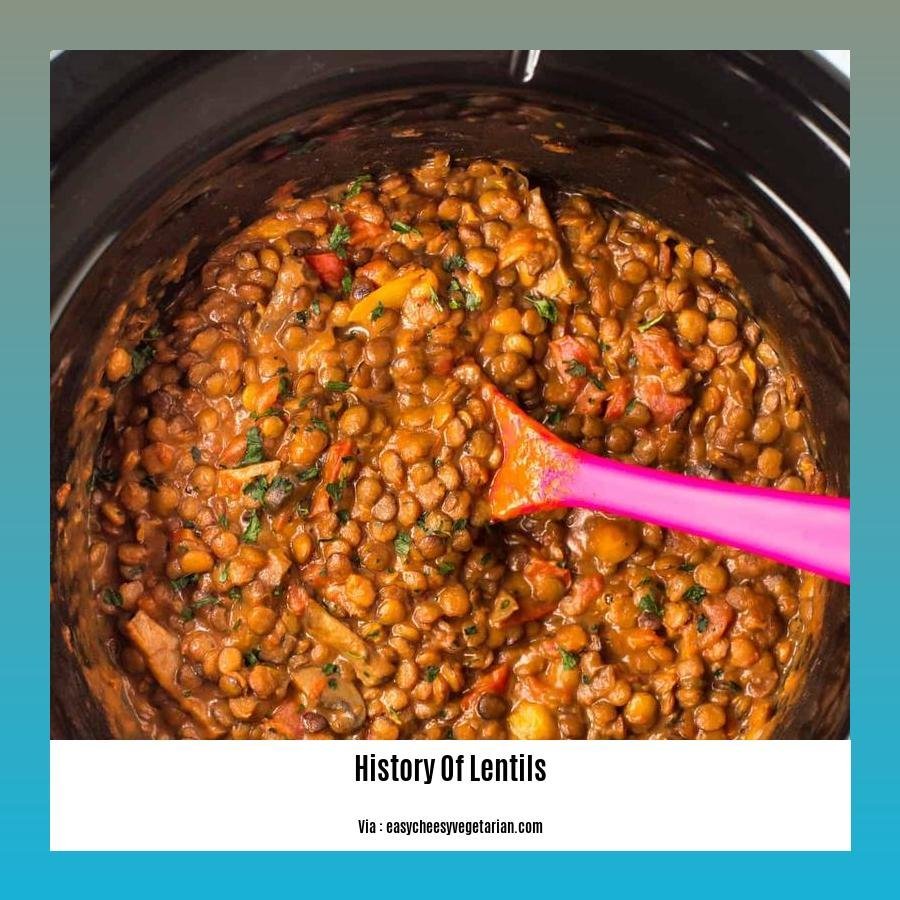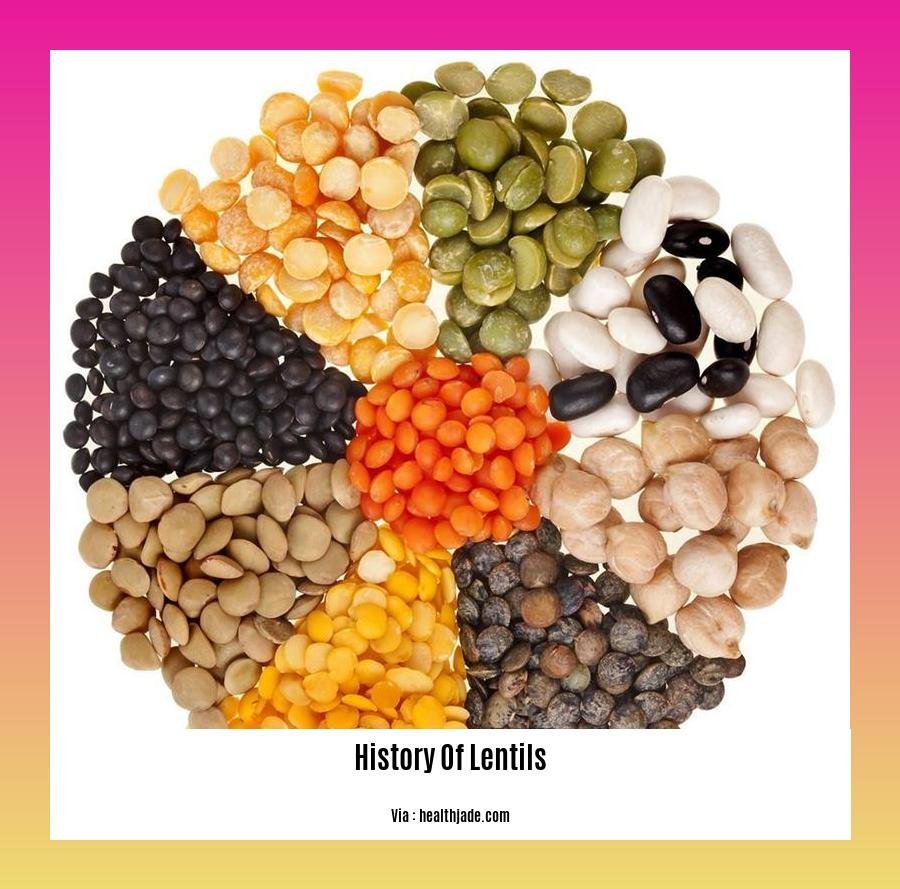Embark on a fascinating culinary expedition with us as we delve into the rich and captivating history of lentils in our latest article, “A Culinary Journey Through Time: Exploring the History of Lentils.” Discover the intriguing origin story of this humble yet versatile legume as it left its mark on diverse cultures across the globe. Unveiling the tales behind the dishes and ingredients that have shaped culinary traditions, we shed light on the enduring significance of lentils throughout the ages.
Key Takeaways:
- Lentils have a rich history dating back millennia, originating in the Near East or Mediterranean region.
- With over 50 cultivated varieties, lentils come in various colors, sizes, and shapes, adapting to different climates and soil conditions.
- Lentils are a valuable plant-based source of protein, dietary fiber, vitamins, and minerals, contributing to overall health and well-being.
- The legume’s versatility allows it to be incorporated into diverse cuisines, including soups, stews, salads, and more, making it a popular ingredient worldwide.
- Lentils hold cultural and religious significance in various communities, associated with prosperity, fertility, and special occasions.
- The Catholic Church’s prohibition on meat consumption during certain periods led to lentils becoming a significant protein source for many people.
- Environmental benefits of lentil production include nitrogen fixation, improved soil health, and water efficiency, making it a sustainable agricultural choice.
- Lentils continue to be a significant culinary staple across cultures, appreciated for their nutritional value, culinary versatility, and historical significance.
History Of Lentils

Unraveling the Ancient Legacy of a Humble Legume
From the vast plains of ancient civilizations to the modern-day kitchens, lentils have embarked on a remarkable culinary journey. These unassuming legumes carry a wealth of historical significance, having nourished humanity for millennia. Join us as we delve into the History of Lentils, tracing their origins, exploring their cultural imprint, and celebrating their enduring role in shaping culinary traditions worldwide.
The Genesis of Lentils: A Tale of Ancient Origins
The humble lentil’s odyssey begins in the fertile crescent, a cradle of civilization nestled between the Tigris and Euphrates rivers. Archaeological evidence suggests that lentils were among the earliest cultivated crops, dating back to 8,000 BC. These nutritious legumes flourished in the region’s temperate climate, providing sustenance to ancient civilizations.
Over time, lentils spread their reach across the globe, becoming a staple in the diets of diverse cultures. From the bustling markets of ancient Rome to the kitchens of medieval Europe, lentils sustained people from all walks of life. Their versatility and affordability made them a cornerstone of culinary traditions, adding protein, fiber, and essential nutrients to meals.
Lentils: A Culinary Canvas of Diversity
The world of lentils is a tapestry of colors, shapes, and flavors. Over 50 varieties of lentils grace the culinary stage, each with its unique characteristics. From the petite red lentils, prized for their vibrant hue and rapid cooking time, to the larger brown lentils, known for their earthy flavor and firm texture, the lentil family offers a kaleidoscope of culinary possibilities.
Lentils lend themselves effortlessly to a myriad of dishes, from hearty soups and stews to vibrant salads and flavorful curries. Their ability to absorb flavors makes them ideal partners for aromatic spices, herbs, and vegetables. In some cultures, lentils take center stage as the main protein, while in others, they play a supporting role, adding texture and depth to dishes.
Beyond Nourishment: Lentils’ Cultural and Symbolic Significance
Lentils have transcended their role as a mere food source, becoming entwined with cultural traditions and beliefs. In ancient Egypt, lentils were associated with the afterlife, often placed in tombs as provisions for the deceased. In India, lentils hold a special place during festivals, symbolizing prosperity and good fortune.
In certain cultures, lentils are believed to bring good luck and abundance. This symbolism has led to traditions such as throwing lentils at weddings or serving lentil dishes on special occasions. The lentil’s humble appearance belies its profound cultural significance, a testament to its enduring presence in human history.
Lentils: A Beacon of Sustainability in a Changing World
In the face of growing environmental challenges, lentils emerge as a beacon of sustainability. Their ability to thrive in diverse climates and their low water requirements make them a resilient crop. Additionally, lentils have a remarkable ability to fix nitrogen in the soil, reducing the need for chemical fertilizers and promoting soil health.
By incorporating lentils into our diets, we not only nourish our bodies but also contribute to a more sustainable food system. Their versatility, nutritional value, and environmental benefits make them a champion of mindful eating.
As we continue our culinary journey, let us pay homage to the humble lentil, a legume that has stood the test of time. Its history is a testament to the resilience and adaptability of our food traditions. Each bite of lentils connects us to our culinary heritage, reminding us of the nourishment, diversity, and sustainability that this ancient grain offers.
curious about the history and significance of Lent? Discover the history of Lent and delve into the origins, traditions, and practices of this important religious observances.
Nutritional Powerhouse: Highlight the nutritional value of lentils, emphasizing their richness in protein, fiber, and essential minerals, and their role in promoting good health.
Lentils, those humble yet mighty legumes, are true nutritional powerhouses. They’re packed with protein, fiber, and essential minerals, making them a nourishing addition to any diet.
Protein Powerhouse:
Lentils are an excellent source of plant-based protein, making them a fantastic alternative for those following vegetarian or vegan diets. Just one cup of cooked lentils provides about 18 grams of protein, which is comparable to the protein content of a serving of meat.
Fiber Fantastic:
Lentils are also an incredible source of fiber, both soluble and insoluble. Soluble fiber helps lower cholesterol and blood sugar levels, while insoluble fiber keeps you feeling full and satisfied, aiding in weight management.
Mineral Marvels:
Lentils are brimming with essential minerals like iron, folate, and potassium. Iron is vital for healthy red blood cell production, folate supports cell growth and development, and potassium contributes to maintaining healthy blood pressure.
Promoting Good Health:
Including lentils in your diet can positively impact your overall health. Their nutritional richness has been linked to reduced risk of heart disease, improved blood sugar control, better digestive health, and even a lower risk of certain types of cancer.
Key Takeaway:
Lentils are an exceptional dietary source of plant-based protein, comparable to meat in protein content.
Lentils are brimming with both soluble and insoluble fiber, aiding in cholesterol and blood sugar management, weight control, and digestive health.
Lentils are rich in vital minerals like iron, folate, and potassium, essential for various bodily functions.
Incorporating lentils into your diet can contribute to a reduced risk of heart disease, improved blood sugar control, better digestive health, and potentially a lower risk of certain cancers.
Source 1
Source 2
Cultural and Historical Significance: Discuss the cultural and historical significance of lentils, including their association with religious observances, symbolic meanings, and their role in shaping culinary traditions.

Have you ever wondered about the cultural and historical significance of lentils? These humble legumes have played a remarkable role in shaping culinary traditions, religious observances, and even symbolic meanings across diverse cultures. Join us as we delve into the fascinating journey of lentils, uncovering their deep-rooted connections with humanity.
Culinary Traditions:
- Lentils have been a culinary staple since ancient times, appearing in recipes from Egypt, Greece, and Rome.
- In Indian cuisine, lentils are a cornerstone ingredient, used in everything from hearty dals to flavorful curries.
- In Mediterranean countries, lentil soups are a beloved comfort food, often served with fragrant herbs and spices.
- In Ethiopia, lentils are a key component of traditional stews like “misir wot,” a spicy and flavorful dish.
Religious Observances:
- In some cultures, lentils hold religious significance. For instance, Catholics traditionally consume lentils during Lent as a meat substitute.
- In Judaism, lentils are often eaten during the festival of Sukkot, symbolizing abundance and prosperity.
- In Hinduism, lentils are considered a sacred food, often offered to deities and consumed during religious festivals.
Symbolic Meanings:
- Lentils have also acquired symbolic meanings across cultures. In some regions, they represent fertility and new beginnings, making them a popular ingredient in wedding and childbirth celebrations.
- In other cultures, lentils symbolize wealth and prosperity. For example, in China, red lentils are often given as gifts during the Lunar New Year to promote good fortune.
Shaping Culinary Traditions:
- Lentils’ versatility and nutritional value have made them a crucial ingredient in many cuisines worldwide.
- Their ability to absorb flavors and textures makes them ideal for soups, stews, salads, and even desserts.
- Lentils’ high protein and fiber content have also contributed to their popularity as a meat alternative, making them a staple in vegetarian and vegan diets.
Key Takeaways:
- Lentils have been a culinary staple for centuries, appearing in diverse cuisines worldwide.
- They hold religious significance in various cultures, often consumed during festivals and observances.
- Lentils carry symbolic meanings, representing fertility, abundance, and prosperity.
- Their versatility and nutritional value have made them a cornerstone ingredient in many culinary traditions.
Sources:
The History and Origin of Lentils – The Spruce Eats
Cultivated lentil (Lens culinaris subsp. culinaris) Domestication
Modern-Day Applications: Touch upon the contemporary uses of lentils in various cuisines, innovative culinary creations, and their growing popularity as a sustainable and nutritious ingredient.
Culinary enthusiasts, brace yourselves for a delectable journey as we unravel the multifaceted world of lentils in modern gastronomy! These humble legumes have transcended time, evolving from ancient staples to contemporary culinary treasures. Lentils are experiencing a resurgence as chefs and home cooks alike discover their versatility, nutritional prowess, and sustainable allure.
Key Takeaways:
Lentils are redefining plant-based cuisine with their impressive protein content, making them a delectable and nutritious alternative to meat. Vegetarian and vegan dishes featuring lentils are gaining immense popularity, catering to health-conscious diners.
Culinary innovators are unleashing their creativity by incorporating lentils into diverse culinary creations. From innovative salads and hearty soups to delectable stews and flavorful curries, lentils are stealing the spotlight in restaurants and kitchens worldwide.
Lentils are not only delicious but also incredibly adaptable. They seamlessly blend into various culinary traditions, adding texture and depth to dishes from diverse cultures. Their versatility makes them a global culinary sensation.
The sustainability of lentils is gaining recognition. They are nitrogen-fixing crops, enriching the soil and reducing the need for chemical fertilizers. Additionally, lentils require less water than many other crops, making them a champion of sustainable agriculture.
Lentils are not just a culinary delight; they are nutritional powerhouses. Packed with protein, fiber, and essential vitamins and minerals, lentils contribute to a balanced and healthy diet. They are a true superfood, nourishing the body and satisfying the taste buds.
Innovative Culinary Creations with Lentils:
Lentil Burgers: These patties pack a punch of flavor and nutrition, showcasing the versatility of lentils as a meat alternative.
Lentil Falafel: A delightful twist on the classic Middle Eastern dish, lentil falafel offers a crispy and protein-rich treat.
Lentil Caviar: A sophisticated appetizer or topping, lentil caviar combines lentils, onions, and herbs to create a briny and umami-rich delicacy.
Lentils in Regional Cuisines:
Indian Dal: A staple in Indian cuisine, dal is a comforting lentil soup or stew bursting with spices and aromas.
Ethiopian Misir Wat: This hearty Ethiopian stew features lentils simmered in a rich sauce of spices and vegetables.
Turkish Mercimek Çorbası: A classic Turkish lentil soup, mercimek çorbası, is a soothing and flavorful dish enjoyed year-round.
French Lentil Salad: A refreshing and vibrant salad featuring lentils, fresh herbs, and a tangy vinaigrette dressing.
Growing Popularity and Sustainability:
- Lentils’ popularity is soaring due to their nutritional value, versatility, and role in sustainable agriculture.
- Their ability to thrive in diverse climates and low water requirements makes them an environmentally friendly crop.
- By incorporating lentils into our diets, we contribute to a more sustainable and healthy food system.
References:
[1] The Lentil: A Humble Pulse with a Rich History
[2] Lentils: A Sustainable and Nutritious Crop
FAQ
Q1: What is the historical significance of lentils?
A1: Lentils have been a staple food in many cultures for centuries, dating back to ancient times. They have been mentioned in biblical texts and archaeological findings, indicating their importance as a source of sustenance and nourishment.
Q2: How have lentils been used throughout history?
A2: Lentils have been used in various ways throughout history, both as a necessity and a delicacy. Depending on the region and culture, lentils have been incorporated into soups, stews, salads, and other dishes, demonstrating their versatility and adaptability in cuisine.
Q3: What are the different types of lentils, and how do they vary?
A3: There are numerous types of lentils, with over 50 varieties cultivated worldwide. These lentils come in various colors, including red, brown, green, and black, and differ in size, shape, and flavor. Some common types include red lentils, brown lentils, and green lentils, each with unique characteristics and culinary applications.
Q4: What are the nutritional benefits of lentils?
A4: Lentils are a rich source of protein, fiber, and essential vitamins and minerals. They are high in protein, making them a valuable plant-based alternative to meat. Lentils are also a good source of iron, folate, and potassium, contributing to overall health and well-being.
Q5: How can lentils be incorporated into a modern diet?
A5: Lentils are a versatile ingredient that can be easily incorporated into a modern diet. They can be used in soups, stews, salads, and various other dishes, adding flavor, texture, and nutritional value. Lentils can also be sprouted and used in salads or as a garnish, providing an extra boost of nutrients.














